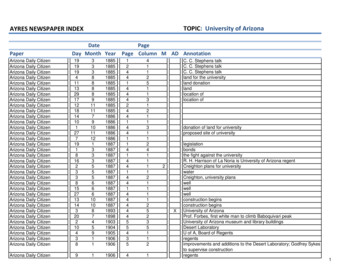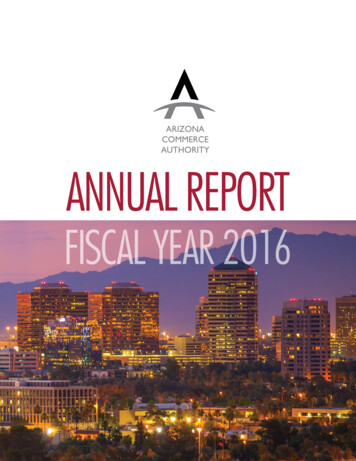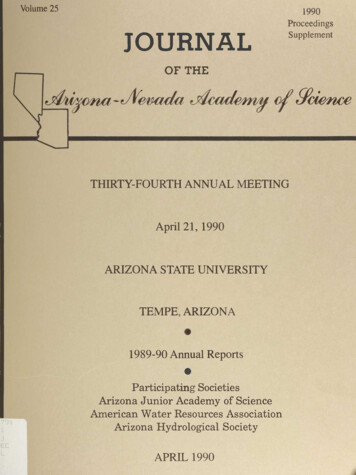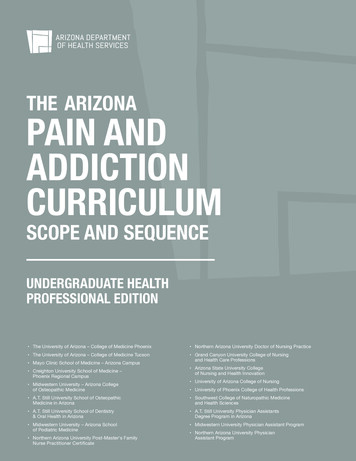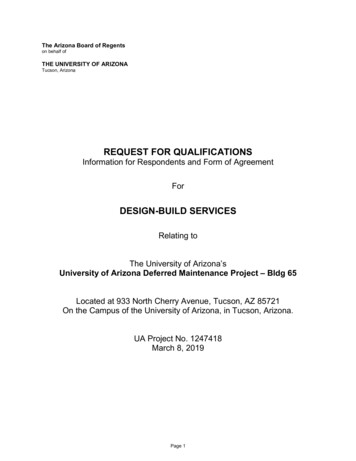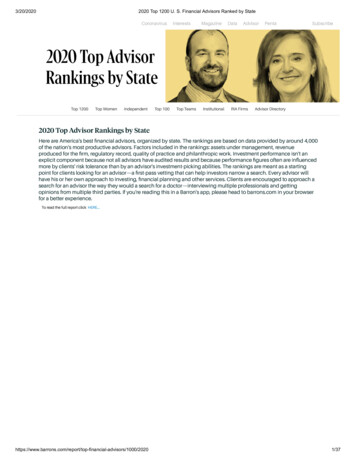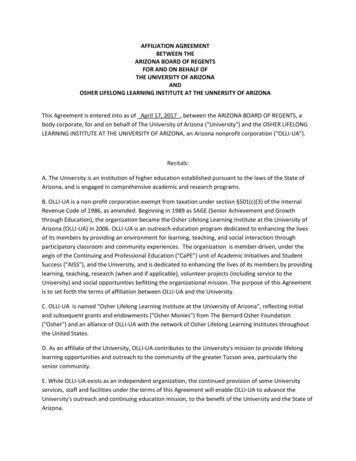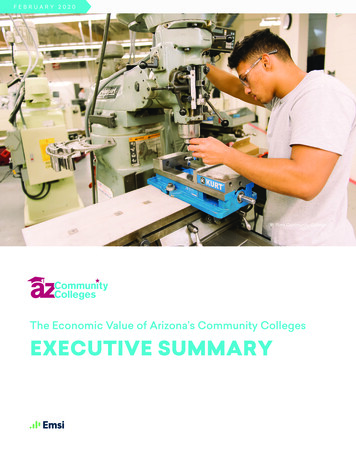
Transcription
FEBRUARY 2020: Pima Community CollegeThe Economic Value of Arizona’s Community CollegesEXECUTIVE SUMMARY
: Arizona Western CollegeAR I Z O N A’ S community colleges create value in many ways. The colleges play a key role in helping students increase their employability andachieve their individual potential. They draw students to and retain students inthe state, generating new dollars and opportunities for Arizona. The collegesprovide students with the education, training, and skills they need to have fulfilling and prosperous careers. Furthermore, the colleges are places for studentsto meet new people, increase their self-confidence, and promote their overallhealth and well-being.Arizona’s community colleges influence both the lives of students and theArizona Western CollegeCentral Arizona CollegeCochise CollegeCoconino Community Collegestate economy. The colleges support a variety of industries in Arizona, serveEastern Arizona Collegestate businesses, and benefit society as a whole in Arizona from an expandedMaricopa County Communityeconomy and improved quality of life. The benefits created by Arizona’s com-College Districtmunity colleges even extend to the state and local governments throughMohave Community Collegeincreased tax revenues and public sector savings.This study measures the economic impacts created by Arizona’s communitycolleges on the business community in the state and the benefits the collegesgenerate in return for the investments made by their key stakeholder groups—Northland Pioneer CollegePima Community CollegeYavapai Collegestudents, taxpayers, and society. The following two analyses are presented:Economic impact analysisInvestment analysisAll results reflect employee, student, and financial data, provided by the colleges,for fiscal year (FY) 2017-18. Impacts on the Arizona economy are reported underthe economic impact analysis and are measured in terms of added income.The returns on investment to students, taxpayers, and society in Arizona arereported under the investment analysis.Introduction 2
Economic impact analysisArizona’s community colleges promote economic growth in Arizona throughtheir direct expenditures and the resulting expenditures of students and statebusinesses. The colleges serve as employers and buyers of goods and servicesI M PAC T S C R E AT E D B YA R I Z O N A’ S C O M M U N I T YC O L L E G E S I N F Y 2017-18for their day-to-day operations. Their activities attract students from outsideArizona and retain students in the state, whose expenditures benefit statevendors. In addition, the colleges are primary sources of higher education toArizona residents and suppliers of trained workers to state industries, enhancing overall productivity in the state workforce.Operations spending impactArizona’s community colleges add economic value to Arizona asemployers of state residents and large-scale buyers of goods and 853.2 millionOperations Spending Impact 3.4 millionConstruction Spending Impactservices. In FY 2017-18, the colleges employed 18,851 full-time andpart-time faculty and staff, 98% of whom lived in Arizona. Total payroll at thecolleges was 835.1 million, much of which was spent in the state for groceries, mortgage and rent payments, dining out, and other household expenses. 475.5 millionStudent Spending ImpactIn addition, the colleges spent 423.3 million on day-to-day expenses relatedto facilities, supplies, and professional services.Day-to-day operations spending from Arizona’s community colleges added 853.2 million in income to the state economy during the analysis year. This 12.8 billionAlumni Impactfigure represents the colleges’ payroll, the multiplier effects generated by thein-state spending of the colleges and their employees, and a downward adjustment to account for funding that the colleges received from state sources.The 853.2 million in added income is equivalent to supporting 18,639 jobsin the state.Construction spending impactArizona’s community colleges invest in construction each year tomaintain facilities, create additional capacities, and meet growingeducational demands. While the amount varies from year to year,these quick infusions of income and jobs have an impact on the state economy. 14.1 billionTOTAL IMPACT– OR –211,258JOBS SUPPORTEDIn FY 2017-18, the colleges’ construction spending generated 3.4 million inadded income, which is equivalent to supporting 83 jobs.Student spending impactSome students attending Arizona’s community colleges originatedfrom outside the state in FY 2017-18, and many of these studentsrelocated to Arizona to attend the colleges. These students mayEconomic impact analysis3
not have come to the state if the colleges did not exist. In addition, some instate students, referred to as retained students, would have left Arizona if notfor the existence of the colleges. While attending the colleges, these relocatedtion, and other household expenses. This spending generated 475.5 millionin added income for the state economy in FY 2017-18, which supported 9,141jobs in Arizona.30,531100 88 77 64 46and retained students spent money on groceries, accommodation, transporta-T O P I N D U S T R Y I M PAC T S O FA R I Z O N A’ S C O M M U N I T Y C O L L E G E S( J O B S S U P P O R T E D)Professional & Technical Services26,901Alumni impactRetail TradeThe education and training the colleges provide for state residentshas the greatest impact. Over the years, students have studied atthe colleges and entered the state workforce with greater knowledge and new skills. Today, hundreds of thousands of former students fromArizona’s community colleges are employed in Arizona. As a result of theireducations at the colleges, the students receive higher earnings and increasethe productivity of the businesses that employ them. In FY 2017-18, alumni ofArizona’s community colleges generated 12.8 billion in added income for thestate economy, which is equivalent to supporting 183,395 jobs.23,446Health Care & Social Assistance19,438Government, Non-Education14,089Real Estate & Rental & LeasingTotal impactArizona’s community colleges added 14.1 billion in income to the Arizonaeconomy during the analysis year, equal to the sum of operations and construction spending impacts, the student spending impact, and the alumni impact.For context, the 14.1 billion impact was equal toapproximately 4.2% of the total gross state product(GSP) of Arizona. This contribution that the collegesprovided on their own is over twice as large as theOne out of every 18 jobs in Arizonaentire Utilities industry in the state.is supported by the activities of theThe total impact of Arizona’s community collegescolleges and their students.can also be expressed in terms of jobs supported.The 14.1 billion impact supported 211,258 statejobs, using the jobs-to-sales ratios specific to eachindustry in the state. This means that one out of every 18 jobs in Arizona issupported by the activities of the colleges and their students. In addition, the 14.1 billion, or 211,258 supported jobs, stemmed from different industry sectors. Among non-education industry sectors, spending and alumni of Arizona’scommunity colleges in the Professional & Technical Services industry sectorsupported 30,531 jobs in FY 2017-18. These are impacts that would not havebeen generated without the colleges’ presence in Arizona.Economic impact analysis4
Investment analysisAn investment analysis evaluates the costs associated with a venture againstits expected benefits. If the benefits outweigh the costs, then the investmentis financially worthwhile. The analysis presented here considers Arizona’scommunity colleges, collectively, as an investment from the perspectives ofstudents, taxpayers, and society in Arizona.Student perspectiveIn FY 2017-18, Arizona’s community colleges served 293,651 creditand 37,617 non-credit students. In order to attend the colleges, thestudents paid for tuition, fees, books, and supplies. They also tookS T U D E N T S S E E A H I G H R AT E O FRETURN FOR THEIR INVESTMENT INA R I Z O N A’ S C O M M U N I T Y C O L L E G E Sout loans and will incur interest on those loans. Additionally, students gave up39 20 219.5%money they would have otherwise earned had they been working instead ofAverage annual return for studentsat Arizona’s community collegesattending college. The total investment made by students at Arizona’s community colleges in FY 2017-18 amounted to a present value of 1.3 billion,9.9%equal to 356.8 million in out-of-pocket expenses (including future principalStock market 30-yearaverage annual returnand interest on student loans) and 899.9 million in forgone time and money.In return for their investment, students of Arizona’s community colleges will0.8%receive a stream of higher future earnings that will continue to grow throughoutInterest earned on savings account(National Rate Cap)their working lives. For example, the average associate degree graduate from anArizona community college in FY 2017-18 will see annual earnings 8,100 higherthan a person with a high school diploma or equivalent working in Arizona.Source: Forbes’ S&P 500, 1989-2018. FDIC.gov, 6-2019.Over a working lifetime, the benefits of the associate degree over a high schooldiploma will amount to an undiscounted value of 332.1 thousand in higher earnings per graduate. The present value of the cumulative higher future earningsthe FY 2017-18 students will receive over their working careers is 6.8 billion.The average associate degree graduate from an Arizona communitycollege will see an increase in earnings of 8,100 each year comparedto a person with a high school diploma or equivalent working in Arizona.44 576473 100 High schoolHigh schoolCertificateAssociateBachelor’s 22,400 28,700 32,600 36,800 50,600Source: Emsi employment data.Investment analysis5
The students’ benefit-cost ratio is 5.4. In other words, for every dollar studentsinvest in education at Arizona’s community colleges, in the form of out-of-pocketexpenses and forgone time and money, they will receive a cumulative value of 5.40 in higher future earnings. Annually, the students’ investment in the colleges has an average annual internal rate of return of 19.5%, which is impressivecompared to the U.S. stock market’s 30-year average rate of return of 9.9%.STUDENT PERSPECTIVE 6.8 billionPresent value benefits 1.3 billionTaxpayer perspectivePresent value costsArizona’s community colleges generate more in tax revenue thanthey take. These benefits to taxpayers consist primarily of taxes thatthe state and local government will collect from the added revenuecreated in the state. As students from the colleges will earn more, they will makehigher tax payments throughout their working lives. Students’ employers will 5.5 billionNet present valueBenefit-cost ratioRate of return5.419.5%also make higher tax payments as they increase their output and purchasesof goods and services. By the endof the FY 2017-18 students’ workinglives, the state and local governmentswill have collected a present value ofFor every dollar ofTAXPAYER PERSPECTIVE 2.0 billion 1.9 billion in added taxes.public money investedPresent value benefitsBenefits to taxpayers will also consistin Arizona’s community 951.3 millionof savings generated by the improvedlifestyles of students from Arizona’scommunity colleges and the corresponding reduced governmentservices. Education is statisticallycorrelated with a variety of lifestylechanges. Students’ educations fromthe colleges will generate savings incolleges, taxpayers willreceive a cumulativevalue of 2.10 over thecourse of the students’Present value costs 1.0 billionNet present valueBenefit-cost ratioRate of return2.15.7%working lives.three main categories: 1) healthcare,2) crime, and 3) income assistance.Improved health will lower students’ demand for national health care services. Inaddition, students will be less likely to interact with the criminal justice system,resulting in a reduced demand for law enforcement and victim costs. Studentsfrom Arizona’s community colleges will be more employable, so their reducedSOCIAL PERSPECTIVE 25.7 billionPresent value benefits 2.3 billiondemand for income assistance such as welfare and unemployment benefits willPresent value costsbenefit taxpayers. For a list of study references, contact the Arizona Community 23.4 billionCollege Coordinating Council for a copy of the main report. Altogether, the present value of the benefits associated with education provided by Arizona’s community colleges will generate 142.2 million in savings to state and local taxpayers.Net present valueBenefit-cost ratioRate of return11.1n/a*Total taxpayer benefits amount to 2 billion, the present value sum of the addedtaxes and public sector savings. Taxpayer costs are 951.3 million, equal to theamount of state and local government funding Arizona’s community collegesreceived in FY 2017-18. These benefits and costs yield a benefit-cost ratio* The rate of return is not reported for the social perspective because the beneficiaries of the investmentare not necessarily the same as the original investors.Numbers may not add due to rounding.Investment analysis6
of 2.1. This means that for every dollar of public money invested in Arizona’scommunity colleges in FY 2017-18, taxpayers will receive a cumulative value of 2.10 over the course of the students’ working lives. The average annual internalrate of return for taxpayers is 5.7%.Social perspectiveSociety as a whole in Arizona benefits from the presence of Arizona’s community colleges in two major ways. Primarily, societybenefits from an increased economic base in the state. This isattributed to higher student earnings and increased business output, whichraise economic prosperity in Arizona.Benefits to society also consist of the savings generated by the improved lifestyles of the colleges’ students. As discussed in the previous section, educationis statistically correlated with a variety of lifestyle changes that generate socialsavings. Note that these costs are avoided by the consumers but are distinctfrom the costs avoided by the taxpayers outlined above. Healthcare savingsinclude avoided medical costs associated with smoking, alcohol dependence,obesity, drug abuse, and depression. Savings related to crime include reducedsecurity expenditures and insurance administration, lower victim costs, andreduced expenditures by the criminal justice system. Income assistance savings include reduced welfare and unemployment claims.SOCIAL BENEFITS INA R I Z O N A F R O M A R I Z O N A’ SCOMMUNITY COLLEGESSocial savings 390.4 million98 2 P98 25.7 billionTotal benefitsto societyAdded income 25.3 billionAltogether, the social benefits from Arizona’s community colleges equal a present value of 25.7 billion. These benefits include 25.3 billion in added incomethrough students’ increased lifetime earnings and increased business output,as well as 390.4 million in social savings related to health, crime, and incomeassistance in Arizona. People in Arizona invested a present value total of 2.3billion in the colleges in FY 2017-18. These costs include all of the colleges’expenditures and student costs.The benefit-cost ratio for society is 11.1, equal to the 25.7 billion in benefitsdivided by the 2.3 billion in costs. In other words, for every dollar investedin Arizona’s community colleges, people in Arizona will receive a cumulativevalue of 11.10 in benefits. The benefits of this investment will occur for as longas the colleges’ FY 2017-18 students remain employed in the state workforce.Summary of investment analysis resultsThe results of the analysis demonstrate that Arizona’s community colleges arestrong investments for all three major stakeholder groups—students, taxpayers,and society. As shown, students receive a great return for their investments ineducation at the colleges. At the same time, taxpayers’ investment in the colleges returns more to government budgets than it costs and creates a widerange of social benefits throughout Arizona.Investment analysis7
ConclusionThe results of this study demonstrate that Arizona’scommunity colleges create value from multipleperspectives. The colleges benefit state businessesby increasing consumer spending in the state andsupplying a steady flow of qualified, trained workers to the workforce. Arizona’s community collegesThe results of this study demonstratethat Arizona’s community colleges createvalue from multiple perspectives.enrich the lives of students by raising their lifetimeearnings and helping them achieve their individualpotential. The colleges benefit state and local taxpayers through increased taxreceipts and a reduced demand for government-supported social services.Finally, Arizona’s community colleges benefit society as a whole in Arizona: Central ArizonaCollegeby creating a more prosperous economy and generating a variety of savingsthrough the improved lifestyles of students.About the studyData and assumptions used in the study are based on several sources, includingthe FY 2017-18 academic and financial reports from Arizona’s community colleges, industry and employment data from the U.S. Bureau of Labor Statisticsand U.S. Census Bureau, outputs of Emsi’s Multi-Regional Social AccountingMatrix model, and a variety of studies and surveys relating education to socialbehavior. The study applies a conservative methodology and follows standardpractice using only the most recognized indicators of economic impact andinvestment effectiveness. For a full description of the data and approach usedin the study, please contact the Arizona Community College CoordinatingCouncil for a copy of the main report.Emsi is a labor market analytics firm that integrates data from a wide variety of sources to serve professionals in highereducation, economic development, workforce development, talent acquisition, and site selection. Emsi is a leading providerof economic impact studies and labor market data to educational institutions in the U.S. and internationally. Since 2000,Emsi has completed over 2,000 economic impact studies for institutions across three countries. For more informationabout Emsi’s products and services, visit www.economicmodeling.com.Introduction8
In return for their investment, students of Arizona's community colleges will receive a stream of higher future earnings that will continue to grow throughout their working lives. For example, the average associate degree graduate from an Arizona community college in FY 2017-18 will see annual earnings 8,100 higher


